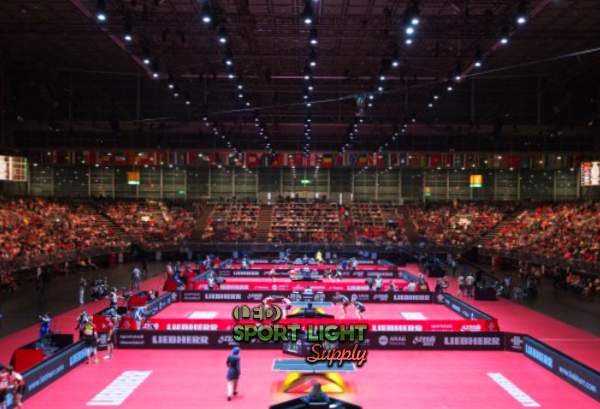When planning the lighting for a table tennis room, it’s essential to determine the necessary lumens and wattage. Lumen is a measure of luminous flux, representing the total visible light output from a light source over a specific time. This metric is crucial in evaluating the performance of lighting fixtures, as higher lumens indicate brighter light.
Table of Contents
ToggleUnderstanding Lumen Requirements for Table Tennis Rooms
When planning the lighting for a table tennis room, understanding the necessary lumens is essential. The amount of light required depends on several factors, including the size of the room and the level of play. To simplify the calculation, let’s assume that the table tennis room is 100 square meters (approximately 1000 square feet).

Impact of Competition Level on Lighting Requirements
The required lumens vary based on the level of competition. Different levels demand different lux levels, which directly impact the lumens needed. Here’s a breakdown of the lux requirements:
| Level of Competition | Lux Requirement |
|---|---|
| Recreational | 200 to 300 lux |
| Local league and national events | 400 to 500 lux |
| International tournaments | 1000 lux (table), 600 lux (elsewhere in playing area) |
| Olympic Games, Paralympics, ITTF World Cup, etc. | 1000 lux (table), 600 lux (elsewhere in playing area) |
For a recreational setting, such as lighting up a ping pong table in your basement or garage, around 300 lux would be sufficient.
Calculating the Required Lumens
To determine the required lumens, we can apply a simple formula. For example, for a 100 square meter recreational room:
Lumen formula = Size of room x Lux x Light Loss Factor
= 100 sq. meter x 300 lux x 1.3
= 39,000 lumens
This calculation shows that approximately 39,000 lumens are required to illuminate a residential table tennis room.
Lumens for Professional and International Events
The lumen requirement increases significantly for higher levels of competition. For instance, the lumen requirement for an Olympic Games or ITTF World Cup arena is:
Lumen formula = Size of room x Lux x Light Loss Factor
= 100 sq. meter x 1500 lux x 1.3
= 195,000 lumens
This example demonstrates the substantial increase in lumens needed to light an arena for international tournaments.
Determining the Wattage for Table Tennis Room Lighting
After calculating the required lumens, the next step is to determine the necessary wattage for LED lights. The conversion between lumens and watts depends on the luminous efficacy of the light source. For LEDs, which typically offer around 150 lumens per watt, the conversion is straightforward.
Conversion Between Lumens and Watts
For a recreational table tennis room requiring 39,000 lumens:
Watts = Lumens ÷ Lumens per Watt
= 39,000 lumens ÷ 150 lumens/watt
= 260 watts
Therefore, approximately 260 watts of LED lighting would be needed to illuminate a 100 square meter garage.
Wattage for Professional Table Tennis Arenas
For larger venues such as arenas hosting national or international events, the wattage requirement can be significantly higher. Depending on the size of the venue and the lighting standards required, the wattage can range from 5000 to 20,000 watts.
It’s essential to note that the above calculations are based on an area of 100 square meters. If your table tennis venue is larger or smaller, you can simply multiply the corresponding values to find the appropriate lumens and wattage.

Adjusting for Ceiling Height
Another important factor to consider is the ceiling height of the table tennis room. Higher ceilings can lead to greater light loss, which may necessitate an increase in wattage. This is because the light must travel a greater distance to reach the playing surface, reducing its intensity.
The Importance of Photometric Reports
While the above calculations provide a general guideline, achieving optimal lighting requires precise planning. To accurately estimate the lumen and power requirements, it’s advisable to obtain a photometric report. These reports, often generated using DIALux or RELUX software, allow lighting engineers to simulate the lighting in a 3D model of the room. By adjusting the position and number of lights, the software can generate an accurate lux value for the playing area.
Photometric reports are invaluable for ensuring that the lighting design meets the specific requirements of the venue. They consider factors such as ceiling height, room size, and the placement of fixtures to provide a tailored lighting solution.
Requesting a Free Lighting Design Service
If you’re planning to light a table tennis venue, whether for recreational or professional use, precise lighting design is crucial. Understanding the necessary lumens and wattage is the first step, but the final design should consider all variables, including room size, ceiling height, and the level of play.
To assist with this process, we offer a free lighting design service. Our team of lighting engineers can create a custom lighting plan for your venue, ensuring that it meets all necessary standards. By using advanced software, we can simulate the lighting in your room and provide a detailed report outlining the required lumens and watts.
Whether you’re lighting a small basement or a large arena, we’re here to help you achieve the perfect lighting setup. Feel free to contact us for more information or to request your free lighting design.
Conclusion
By carefully calculating the required lumens and wattage, considering factors such as competition level and ceiling height, and utilizing photometric reports, you can ensure that your venue is well-lit to meet specific needs. If you need assistance, our free lighting design service is available to help you achieve the best possible lighting solution for your table tennis venue.
